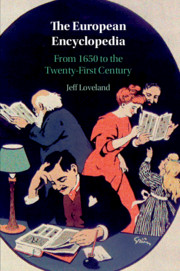Book contents
- The European Encyclopedia
- The European Encyclopedia
- Copyright page
- Contents
- Figures
- Tables
- Chronological List of Printed Encyclopedias
- Acknowledgments
- Introduction
- Chapter 1 Genres of Encyclopedias
- Chapter 2 The Contents of Encyclopedias
- Chapter 3 Size, Price, and the Economics of Encyclopedias
- Chapter 4 Preparing an Encyclopedia
- Chapter 5 The Organization of Encyclopedias
- Chapter 6 Illustrations in Encyclopedias
- Chapter 7 Authorship in Encyclopedias
- Chapter 8 Publishing an Encyclopedia
- Chapter 9 Readers and Users of Encyclopedias
- Chapter 10 Encyclopedias after Print
- Bibliography
- Index
Chapter 9 - Readers and Users of Encyclopedias
Published online by Cambridge University Press: 27 June 2019
- The European Encyclopedia
- The European Encyclopedia
- Copyright page
- Contents
- Figures
- Tables
- Chronological List of Printed Encyclopedias
- Acknowledgments
- Introduction
- Chapter 1 Genres of Encyclopedias
- Chapter 2 The Contents of Encyclopedias
- Chapter 3 Size, Price, and the Economics of Encyclopedias
- Chapter 4 Preparing an Encyclopedia
- Chapter 5 The Organization of Encyclopedias
- Chapter 6 Illustrations in Encyclopedias
- Chapter 7 Authorship in Encyclopedias
- Chapter 8 Publishing an Encyclopedia
- Chapter 9 Readers and Users of Encyclopedias
- Chapter 10 Encyclopedias after Print
- Bibliography
- Index
Summary
Writing a history of reading is challenging. Records can be found of those who borrowed or bought books, but people’s interactions with books remain otherwise hard to determine. Above all, exceptional forms of reading are the most likely to leave a discoverable trace. Reviewers and critics compose accounts of their reading, authors and scholars scatter clues about their reading in what they publish, and readers who are struck by a text may refer to the experience of reading it in a letter or diary.
Information
- Type
- Chapter
- Information
- The European EncyclopediaFrom 1650 to the Twenty-First Century, pp. 321 - 357Publisher: Cambridge University PressPrint publication year: 2019
